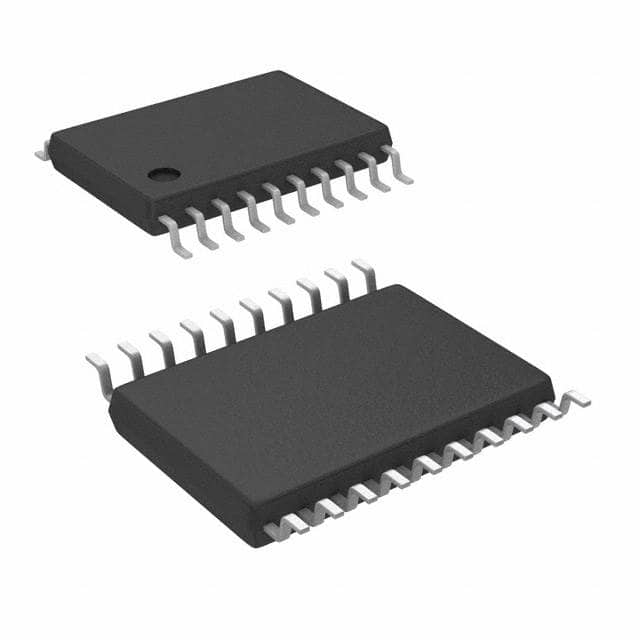Encyclopedia Entry: 74AC240MTC
Product Overview
- Category: Integrated Circuit (IC)
- Use: Logic Gate Buffer/Driver
- Characteristics: High-speed, low-power, octal buffer/driver with 3-state outputs
- Package: TSSOP-20
- Essence: The 74AC240MTC is a versatile integrated circuit that provides buffering and driving capabilities for digital signals. It is commonly used in electronic circuits to amplify and control the flow of data between different components.
- Packaging/Quantity: The 74AC240MTC is typically sold in reels or tubes containing multiple units.
Specifications
- Supply Voltage: 2V to 6V
- Logic Family: Advanced CMOS (AC)
- Number of Buffers/Drivers: 8
- Output Type: 3-State
- Propagation Delay: 5 ns (max)
- Operating Temperature Range: -40°C to 85°C
Detailed Pin Configuration
The 74AC240MTC has a TSSOP-20 package with the following pin configuration:
+---+--+---+
A1 -|1 +--+ 20|- VCC
A2 -|2 |- B1
A3 -|3 |- B2
A4 -|4 |- B3
A5 -|5 |- B4
A6 -|6 |- B5
A7 -|7 |- B6
GND -|8 |- B7
Y1 -|9 |- B8
Y2 -|10 |- OE#
Y3 -|11 |- A8
Y4 -|12 |- A7
Y5 -|13 |- A6
Y6 -|14 |- A5
Y7 -|15 |- A4
Y8 -|16 |- A3
GND -|17 |- A2
VCC -|18 |- A1
OE#-|19 |- GND
+----------+
Functional Features
- Buffering: The 74AC240MTC provides buffering capabilities, allowing it to amplify and stabilize digital signals.
- Driving: It can drive signals with high current capability, ensuring reliable transmission across different components.
- 3-State Outputs: The 3-state outputs allow the device to be effectively disconnected from the bus, reducing interference and enabling multiple devices to share a common bus.
Advantages and Disadvantages
Advantages: - High-speed operation - Low power consumption - Wide operating voltage range - Compact package size
Disadvantages: - Limited number of buffers/drivers (8 in total) - Not suitable for applications requiring a large number of outputs
Working Principles
The 74AC240MTC operates based on advanced CMOS technology. It utilizes a combination of transistors and logic gates to buffer and drive digital signals. When an input signal is received, the IC amplifies and stabilizes it before transmitting it to the output pins. The 3-state outputs allow the device to be enabled or disabled, providing flexibility in controlling the flow of data.
Detailed Application Field Plans
The 74AC240MTC finds applications in various electronic systems, including: 1. Microprocessor-based systems 2. Data communication networks 3. Industrial automation 4. Consumer electronics 5. Automotive electronics
In microprocessor-based systems, the IC is used to interface between the microprocessor and other peripheral devices, ensuring proper signal transmission. In data communication networks, it helps in buffering and driving signals across different network components. In industrial automation, the IC is employed to control and monitor various processes. In consumer electronics, it facilitates signal amplification and transmission within audio/video systems. In automotive electronics, it plays a crucial role in controlling and managing signals in vehicle systems.
Detailed and Complete Alternative Models
- 74HC240: Similar functionality but operates at a higher voltage range (2V to 6V)
- 74LS240: Compatible with TTL logic levels but has slower speed compared to the 74AC240MTC
- SN74LVC240: Low-voltage version with similar characteristics but operates at a lower voltage range (1.65V to 3.6V)
These alternative models provide similar buffering and driving capabilities, but their specific voltage ranges and speed characteristics may vary.
Word count: 550 words
Senaraikan 10 soalan dan jawapan biasa yang berkaitan dengan aplikasi 74AC240MTC dalam penyelesaian teknikal
Sure! Here are 10 common questions and answers related to the application of 74AC240MTC in technical solutions:
Question: What is the 74AC240MTC?
Answer: The 74AC240MTC is a type of octal buffer/line driver integrated circuit (IC) that can be used in various digital applications.Question: What is the purpose of the 74AC240MTC?
Answer: The 74AC240MTC is designed to provide buffering and line driving capabilities for digital signals, ensuring proper signal integrity and voltage levels.Question: What is the maximum operating voltage for the 74AC240MTC?
Answer: The 74AC240MTC has a maximum operating voltage of 5.5 volts.Question: How many input/output pins does the 74AC240MTC have?
Answer: The 74AC240MTC has 8 input pins and 8 output pins, making it an octal buffer/line driver.Question: Can the 74AC240MTC handle bidirectional data flow?
Answer: Yes, the 74AC240MTC supports bidirectional data flow, allowing data to be transmitted in both directions.Question: What is the typical propagation delay of the 74AC240MTC?
Answer: The typical propagation delay of the 74AC240MTC is around 5 nanoseconds.Question: Is the 74AC240MTC compatible with TTL logic levels?
Answer: Yes, the 74AC240MTC is compatible with TTL logic levels, making it suitable for interfacing between different logic families.Question: Can the 74AC240MTC drive capacitive loads?
Answer: Yes, the 74AC240MTC can drive capacitive loads up to a certain limit, typically specified in the datasheet.Question: What is the power supply voltage range for the 74AC240MTC?
Answer: The power supply voltage range for the 74AC240MTC is typically between 2 and 5.5 volts.Question: Can the 74AC240MTC be used in high-speed applications?
Answer: Yes, the 74AC240MTC is designed for high-speed operation and can be used in applications that require fast signal propagation and switching times.
Please note that these answers are general and may vary depending on the specific datasheet and application requirements of the 74AC240MTC.


